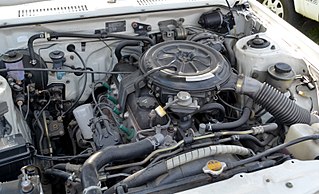Related Research Articles

The Toyota A Series engines are a family of inline-four internal combustion engines with displacement from 1.3 L to 1.8 L produced by Toyota Motor Corporation. The series has cast iron engine blocks and aluminum cylinder heads. To make the engine as short as possible, the cylinders are siamesed.

The Daihatsu Terios is a mini SUV produced by the Japanese automobile manufacturer Daihatsu since 1997 as the successor to the F300 series Rocky. It was initially offered in both short- and long-wheelbase configurations before the former stopped production in 2016 to be replaced by the A200 series Rocky crossover in 2019. The long-wheelbase variant is available mainly for the Indonesian market with three-row seating options. A smaller kei car model called the Terios Kid/Lucia was also available for the first-generation model.

The Toyota K series is an inline-four engine that was produced from 1966 through 2007. It is a two-valve pushrod engine design. It was originally built from the Toyota Kamigo plant in Toyota City factory in Japan.

The Toyota KR engine family is a straight-3 piston engine, designed by Daihatsu, a subsidiary of Toyota. The 1KR series uses aluminium engine blocks and chain driven DOHC cylinder heads. It uses multi-point fuel injection, and has 4 valves per cylinder. Some versions have VVT-i variable valve timing. The engine is exceptionally light: 69 kg (152 lb) with all ancillaries.

The Toyota HD is a series of Diesel engines produced by Toyota.

The Daihatsu Hijet is a cab over microvan and kei truck produced and sold by the Japanese automaker Daihatsu since 1960. Despite the similarities between the Hijet name and Toyota's naming scheme for its trucks and vans, the name "Hijet" has been in use for Daihatsu's kei trucks and microvans since 1960, over two decades before Toyota took control. "Hijet", when transliterated into Japanese, is very similar to "Midget", one of Daihatsu's other mini-trucks. According to Daihatsu, the name "Hijet" was created to imply that the vehicle offers higher performance than the Midget. The Hijet competes in Japan with the Honda Acty, Mitsubishi Minicab, Nissan Clipper, Subaru Sambar and Suzuki Carry.
The Toyota B engine family was a series of inline-four diesel engines.

The Toyota SZ engine family is a series of straight-4 piston engines with a forward-facing exhaust. Toyota Motor Manufacturing (UK) in Deeside produces SZ engines for the Yaris. All three types of the SZ engine are built in Tianjin FAW Toyota Engine Co., Ltd. (TFTE) Plant No. 1 in Xiqing District, Tianjin, China. The 2SZ-FE and 3SZ-FE variations are also manufactured by PT Astra Daihatsu Motor's Karawang Engine Plant in Indonesia.

The Toyota Y engine is a series of overhead valve straight-four petrol engines manufactured by Toyota from 1982 through 1996. The Y engine has mostly been used in commercial and off-road vehicles.

The EN series engine is a four-cylinder, four-stroke engine used in kei cars sold by Subaru in Japan, succeeding the EK family of two-cylinder engines previously used in Subaru kei cars from 1958 to 1989. The EN family was introduced in 1989 and discontinued in 2012.

The Toyota NR engine family is a series of small inline-four piston engines designed and manufactured by Toyota, with capacities between 1.2 and 1.5 litres.

The Daihatsu E-series engine is a range of compact three-cylinder, internal combustion piston engines, designed by Daihatsu, which is a subsidiary of Toyota. The petrol-driven series has cast iron engine blocks and aluminum cylinder heads, and are of either SOHC or DOHC design, with belt driven heads.

The Daihatsu Zebra is a series of cab over vans and pickup trucks produced and sold by Japanese automaker Daihatsu's Indonesian subsidiary from 1986 to 2007.
The Daihatsu C-series engine is a range of compact three-cylinder, internal combustion piston engines, designed by Daihatsu, which is a subsidiary of Toyota. The engines range from 843 to 993 cc and have been manufactured in petrol and diesel-driven series. They have cast iron engine blocks and aluminum cylinder heads, and are of either SOHC or DOHC design, with belt driven heads. The engine first appeared in the all-new Daihatsu Charade in October 1977, in "CB20" form.

The Suzuki F engine is a series of inline three- and four-cylinder internal combustion petrol engines manufactured by Suzuki Motor Corporation and also licensed by many manufacturers for their automobiles. This engine was Suzuki's first four-stroke car engine when it first appeared in 1977.

The Daihatsu J-series engine is a series of the inline-four engines specially for Daihatsu's kei cars that was produced from August 1994 to August 2012. This was the only inline-four engine for Daihatsu's kei cars, debuted in the L502 Daihatsu Mira that was launched in September 1994.
References
- ↑ Jongeneel, Jeroen (1988-12-10). "Auto test: Daihatsu Charade 1.3i TXF 4WD". Auto Visie (in Dutch) (25). Amsterdam: BV Uitgeversmaatschappij Bonaventura: 29.
- ↑ "2004 DAIHATSU HIJET MAXX S91RP-PMREM". OtoFacts. Archived from the original on 2020-04-12. Retrieved 2020-04-12.
- 1 2 Giebran El Rizani, Nabiel (2019-09-30). "Berminat Beli Daihatsu Taruna? Perhatikan Penyakit yang Sering Dialami (Interested in Taruna? Pay attention to these problems)" (in Indonesian). Jip.Gridoto.com. Retrieved 2020-04-14.
- 1 2 3 Dayat, Jal (2019-08-02). "Kelebihan dan kekurangan Daihatsu Espass (The advantages and disadvantages of Daihatsu Espass)" (in Indonesian). Jaldayat.com. Retrieved 2020-04-14.
- ↑ Alfan, Charis (2016-05-21). "Shelby Patriot (Daihatsu Zebra S90)" (in Indonesian). Mobil Motor Lama. Retrieved 2020-04-12.